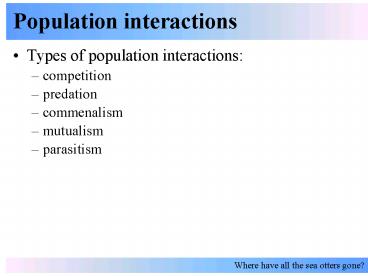Types of population interactions: - PowerPoint PPT Presentation
1 / 14
Title:
Types of population interactions:
Description:
... the sea otters gone? ... Where have all the sea otters gone? Gause (1935) found some species ... for resources (e.g. lions and hyenas at a carcass) ... – PowerPoint PPT presentation
Number of Views:455
Avg rating:3.0/5.0
Title: Types of population interactions:
1
Population interactions
- Types of population interactions
- competition
- predation
- commenalism
- mutualism
- parasitism
Where have all the sea otters gone?
2
Interspecific competition
- Interspecific competition negative interactions
between species for limited resources
- Classic laboratory experiments demonstrating
interspecific competition
- Gause (1934) interspecific competition among
Paramecium
Where have all the sea otters gone?
3
Interspecific competition
- Principle of competitive exclusion if two
species compete for a limited resource, the
species that uses the resource more efficiently
will drive the other species to local extinction
Where have all the sea otters gone?
4
Interspecific competition
- Gause (1935) found some species could coexist
- Species coexist if they do not use resources in
exact same way
Where have all the sea otters gone?
5
Interspecific competition
- Types of interspecific competition
- interference competition physical confrontations
for resources (e.g. lions and hyenas at a carcass)
- exploitative competition consumption of shared
resources (e.g. Paramecium feeding on bacteria)
- Intensity of interspecific competition depends on
abundance of resource and niche overlap
- Niche all the ways in which an organism uses
resources in its environment
Where have all the sea otters gone?
6
Interspecific competition
- Two ways to measure the niche of a species
- Fundamental niche entire niche that a species is
capable of using
- Realized niche actual niche occupied because of
interspecific interactions such as competition
- Measure fundamental and realized niches with
removal experiments
- Connell (1961) interspecific competition between
barnacles on the rocky intertidal zone
Where have all the sea otters gone?
7
Interspecific competition
- Connells (1961) classic experiment
- Two species of barnacles in Scotland
- Chthamalus small size, upper portion of
intertidal zone
- Semibalanus large, lower-mid portions of
intertidal zone
- Connell (1961) removed each species to
investigate the reason for vertical zonation
between barnacles
Where have all the sea otters gone?
8
Interspecific competition
- Connells (1961) classic experiment
- Chthamalus has larger fundamental niche than
Semibalanus only Chthamalus can tolerate upper
site
- Semibalanus outcompetes Chthamalus in mid and
lower zones
Where have all the sea otters gone?
9
Interspecific competition
- Observational evidence of interspecific
competition
- If two species evolve in competition, selection
may favor changes in one or both species that
leads to resource partitioning (subdivision of a
niche)
Where have all the sea otters gone?
10
Interspecific competition
- Observational evidence of interspecific
competition
- Character displacement differences in
morphology between two species when sympatric but
not allopatric
Where have all the sea otters gone?
11
Symbiotic relationships
- Coevolution long-term, mutual evolutionary
changes between closely interacting species
- Coevolution can lead to symbiosis ( two or more
species living in a close association)
- Types of symbiotic relationships
- Commensalism one species benefits and the other
species neither benefits or is harmed by the
association
- Mutualism both species benefit by the association
- Parasitism one species benefits and the other
species is harmed by the association
- Classifying symbiotic relationships difficult
requires experiments
Where have all the sea otters gone?
12
Symbiotic relationships
- Commensalism
- Clownfish and sea anemones oxpeckers and grazers
Where have all the sea otters gone?
13
Symbiotic relationships
- Mutualism
- Pollination Ants and Acacia trees
Where have all the sea otters gone?
14
Symbiotic relationships
- Parasitism
- Ectoparasites, endoparasites, brood parasites
Where have all the sea otters gone?






























